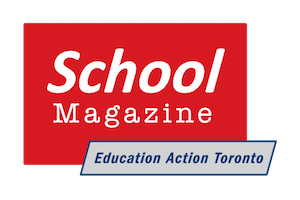Ontario schools and the structural deficit: Looking everywhere but at the problem
The Ford government is, once again, pointing its finger in the wrong direction, blaming school boards for not getting by on less money to fund their operations. For years, boards have routinely been slipping deeper into the water as they beg the Ministry of Education to let them run annual deficits or spoon off their reserve funds to balance their budgets.
New Education Minister Paul Calandra is trying a get-tough approach, sending investigators into the cash-strapped Toronto, Toronto Catholic and Ottawa Carleton District School Boards to find out why they keep posting a structural deficit that has become part of their annual financial reckoning. It’s not a good look for Calandra as he watches the Ottawa Carleton DSB plan to cut teachers or the Toronto DSB get everyone’s attention by considering cuts to public use of swimming pools. Find another way of doing the Ministry’s bidding, he warns, or we’ll put you under supervision.
A bigger problem than three boards running deficits
Except that it’s not just these three boards that are in trouble – 40 percent of them ran deficits for the 2024-25 school year. With that many boards under the gun, the finger needs to be pointed back at Calandra’s ministry. What’s really the source of the structural deficit across the province? Despite Doug Ford’s repeated claims that Ontario spends more and more money on education, it isn’t even keeping up with inflation. Finance Minister Peter Bethlenfalvy says that the province is adding 2.6 percent to per-pupil funding in 2025-26. Other than that, there’s not much else about education in the budget and we’ll need to wait and see what money actually comes forward.
 For the last couple of years Ricardo Tranjan of the Canadian Centre for Policy Alternatives has calculated the drop in provincial funding for each student since 2018 when the Tories first came to power. In 2018 the funding for each kid’s education was $12 300 which adjusted to today’s inflation, comes to $14 700. He compared that to the $13 200 the Tories said was more money they were spending last year, did a subtraction and came up with the now frequently cited figure for per-pupil underspending of $1 500. Now that’s a structural deficit.
For the last couple of years Ricardo Tranjan of the Canadian Centre for Policy Alternatives has calculated the drop in provincial funding for each student since 2018 when the Tories first came to power. In 2018 the funding for each kid’s education was $12 300 which adjusted to today’s inflation, comes to $14 700. He compared that to the $13 200 the Tories said was more money they were spending last year, did a subtraction and came up with the now frequently cited figure for per-pupil underspending of $1 500. Now that’s a structural deficit.
But wait, there’s more. What about the generational backlog in school repairs that places a burden on local school boards to keep their community members safe and healthy? In the absence of government activity in the area, boards are stuck with maintenance costs to schools that are just going to get worse over the next ten years to the tune of $21.7 billion. By the way, the Toronto and Toronto Catholic boards are at the bottom of the list of boards with schools in a good state of repair.
The Ministry diverts money from schools according to Holt Stuart-Hitchcox and Lana Parker in their recent article in Our Schools Ourselves. To graduate from secondary school, students need to take at least 2 online courses, something for which the Ministry has projected cost benefits that it removed from school board funding. It has also entered into agreements with publishers like Pearson, Nelson and Acadience for learning materials. This comes to another $25.5 million that won’t be finding its way into schools. And remember the COVID-19 per child payments of $200-$250 and $400-$500 respectively given directly to parents? That was more money boards desperately needed but didn’t get as they were coping with the COVID-19 reality in their schools along with the aftermath of two lost years of school. The province provided about enough money to hire 1.5 additional staff per school during the crisis. It decided that once the immediate crisis was over, it could discontinue the funding. But students didn’t adjust so easily and boards are left to deal with related lingering academic and social problems of kids missing a couple of years of school.
Diverting attention
 The Ministry has no interest in addressing the varying conditions surrounding school board budgets – why one board has different problems to address than another. These range from increasing violence in classrooms, older and thus higher paid teachers, burnout, aging buildings, local cost of living, neighbourhood inequities and so on. These are just a few of the elements missing from a proper funding formula, for which friends of education have begged for years. That’s not likely to happen anytime soon, so Calandra takes the simplistic approach: too many superintendents to run boards whom he claims aren’t managing, too many teachers cruising on the Sunshine List at over $100 000 a year in pay, too many staff on paid absence – whatever that means.
The Ministry has no interest in addressing the varying conditions surrounding school board budgets – why one board has different problems to address than another. These range from increasing violence in classrooms, older and thus higher paid teachers, burnout, aging buildings, local cost of living, neighbourhood inequities and so on. These are just a few of the elements missing from a proper funding formula, for which friends of education have begged for years. That’s not likely to happen anytime soon, so Calandra takes the simplistic approach: too many superintendents to run boards whom he claims aren’t managing, too many teachers cruising on the Sunshine List at over $100 000 a year in pay, too many staff on paid absence – whatever that means.
Right – teachers are getting paid more, particularly when the Ford gambit of holding pay increases to 1 percent per year was found unconstitutional and they started moving up towards that magical $100 000 figure. By the way, they’re no different than other education workers filling about 107 pages on the Sunshine List – some of whom are right in Calandra’s office. There are currently 377 665 workers on the Ontario Sunshine list. What’s his point?
And right again! Staff get sick and have contractual access to sick leave. So, what’s he going to do – cut back on sick leave, clamp down on illness, hunt out malingerers?
Why not just determine and pay the cost of sending kids to school?
Recent Toronto DSB finance submissions give some insight.1 As with other boards, the Ministry doesn’t fund the full increase over the years, in statutory benefits – Canada Pension Plan (CPP) and Employment Insurance (EI)- leaving the board short by $43.7 million for these definitely-not-optional expenses.
There’s a difference in salary costs for teachers. In 2014, when the Province began bargaining teacher salaries, the salary grid it adopted was lower than the one used by the TDSB. The difference was unfunded and, in 2024-25 sits at $26.1 million.
Toronto operates some schools that are under capacity, but since 2017, the Ministry hasn’t allowed them to be shuttered. Prior to 2015, the Ministry recognized that it costs about the same to operate a school at full-capacity as it did for one that is under-enrolled. The TDSB used to receive $35.5 million from the Ministry until it decided to phase out the grant and leave Toronto to pay the building costs of schools it can’t close. In 2024-25, that amount was estimated to be $43.1 million.
The TDSB is projecting a $58 million deficit for the coming year. Its deficit recovery plan was rejected by the Ministry and yet the solution is pretty clear: if the Ford government pays the above unavoidable costs of $112.90 million, the TDSB will be ahead of the game.
There’s also the matter of not paying back COVID-19 money. At the height of the pandemic, the Ford government asked the TDSB to take $61 million from it reserve fund to pay costs of keeping school communities safe at a precarious time. That money hasn’t been paid back and according to Trustee Deborah Williams, no reason has been offered. The province is a deadbeat.
Here is one sad story among many of the steady slice of cuts endured by school communities since Ford came to office. Looking back at the 2019-20 TDSB budget it’s the same litany of cuts: 52 teachers-advisors lost to schools, 296 lunchroom supervisors gone, cutbacks to the International languages programme, $2.37 million cut from school budgets as, just like today, school councils argue about whether or not wealthier schools should kick in fundraising profits to a central fund for poorer schools.
Ten psychologists, 3 speech and language pathologists and 4.5 social workers were gone. Outdoor education centres were gutted along with the Itinerant music programme. Sixty maintenance and trade staff were sent packing. It’s been a similar story every year with the same theme: a race to the bottom.
Back to the present. A recent Auditor General report2 pointed out that the TDSB could save $25 million per year if its average sick days were in line with the rest of the province. This is what Paul Calandra was complaining about with his teachers on paid absence remarks. The short story here, according to the Auditor General, is that the board doesn’t stringently enough go after malingerers on sick leave, demanding medical notes, counselling and disciplining staff who don’t comply with the rules; just how many people fall into that group isn’t mentioned. So why doesn’t the TDSB just hire more attendance administrators to find out? It doesn’t have the budget.
Toss a dart in any direction and it will probably stick to a problem with one of the public goods the Ford government is intent on squandering, whether it’s infrastructure, environment, health or education. Its choice is to keep taxes low, give people their money back, curry favour with party supporters and friends and spend as little as it can on developing a sustainable future. This has been blatantly obvious since Ford came to power seven years ago. His government has no sense of the value of strong healthy and safe communities with good schools. That’s the structural deficit his education minister doesn’t want to face.

Notes:
- Toronto District School Board, Finance Budget and Enrolment Committee, Proposed Options to Balance the 2025-26 Budget, April 30, 2025
- Toronto District School Board: Safety, Financial Management and Capital Annual Report 2024, King’s Printer, Ontario, December 2024 pp 37-38

